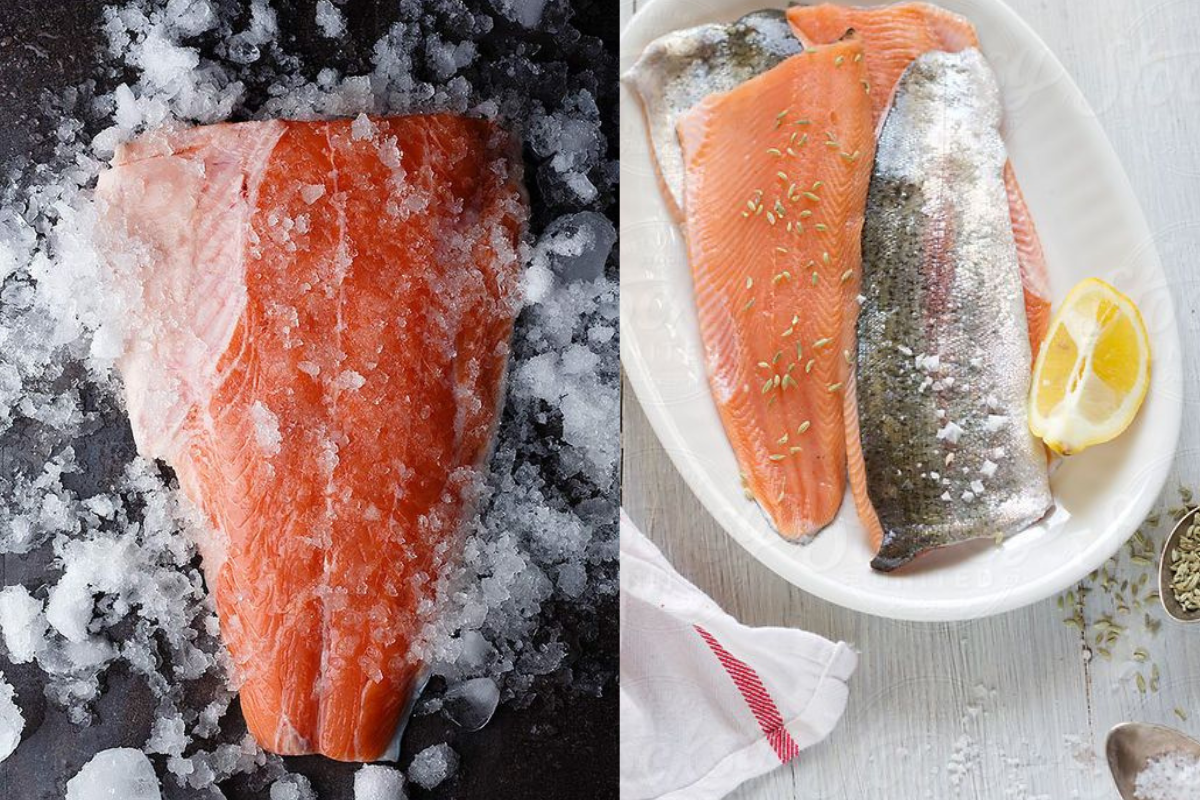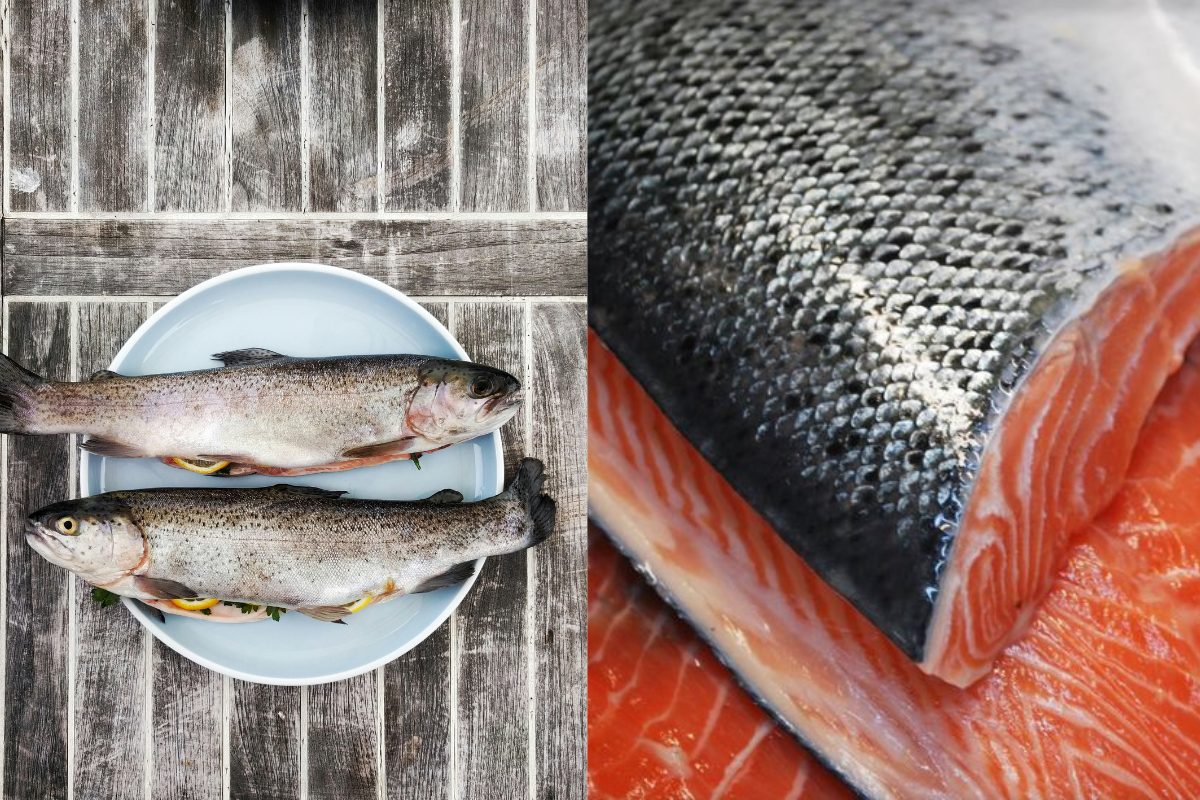Trout and salmon are like the A-listers of the fish world—beloved by seafood enthusiasts and healthy eaters alike. Though they may look somewhat similar at first glance, these two species have their own quirks and flavors that set them apart. Let’s dive in and explore the key differences, including their appearances, habitats, diets, and even their nutritional benefits. Ready to get hooked? Let’s go!
Trout vs Salmon: What’s the Difference?
Though trout and salmon belong to the same fish family (Salmonidae), some noticeable differences make them unique.
- Trout: Typically smaller, trout have a rounded body and are often decorated with spots across their flanks and dorsal fins. These speckled beauties are freshwater fish, thriving in cold rivers and lakes.
- Salmon: These swimmers have more streamlined, torpedo-shaped bodies designed for long ocean journeys. Male salmon also undergo a wild transformation during the spawning season, developing hooked jaws (called kypes) and dramatic color changes. Talk about a glow-up!
Trout vs Salmon Habitat: Home Sweet Home
Where you’ll find them depends largely on their migratory habits and environmental preferences:
- Trout: Found in freshwater rivers, lakes, and streams across North America, Europe, and Asia, trout thrive in cold, oxygen-rich waters. Their world is all about crisp, clear rivers and lakes.
- Salmon: Here’s where salmon go the extra mile. These fish are anadromous, which means they’re born in freshwater, migrate to the ocean to grow, and then return to freshwater rivers to spawn. Imagine going on vacation for years, only to return home to start a family! You’ll find salmon in the North Atlantic and Pacific Oceans, and they can travel hundreds of miles to get back to their birthplace.
What’s on the Menu: Trout vs Salmon Diet
- Trout: A trout’s menu is full of invertebrates, insects, and small crustaceans—although bigger trout aren’t shy about snacking on smaller fish. Their diet largely depends on what’s swimming around in their freshwater homes.
- Salmon: When they’re living in the ocean, salmon feast on fish, squid, and crustaceans. But once they head back to freshwater to spawn, they take a break from eating altogether, living off stored body fat. Sounds like they’re prepping for a big finale!
Reproductive Journey: Trout vs Salmon
- Trout: They like to keep things local. Trout spawn in freshwater, typically in the autumn or spring. Females dig shallow nests, called redds, in gravel to lay their eggs.
- Salmon: Salmon are the ultimate adventurers when it comes to spawning. They make epic migrations from the ocean back to their freshwater homes. After their long journey, females also dig redds to lay eggs, but for many species, the journey is their last, as they die after spawning. It’s a one-way trip for love!

On the topic:
Peach vs Nectarine: Exploring the Differences
Cottage Cheese vs Greek Yogurt: A Nutritional Comparison
Veal vs Beef: Nutrition, Flavor & Cooking – Your Go-To Guide!
Trout vs Salmon Nutrition: Who’s the Healthier Catch?
Both trout and salmon are stars when it comes to nutrition, but there are some slight differences between the two.
| Nutrient | Trout (100g) | Salmon (100g) |
|---|---|---|
| Calories | 190 kcal | 206 kcal |
| Protein | 26 g | 22 g |
| Total Fat | 11 g | 13 g |
| Omega-3s | 951 mg | 1,500 mg |
| Vitamin D | 635 IU | 526 IU |
| Potassium | 481 mg | 363 mg |
| Calcium | 69 mg | 9 mg |
- Salmon: It’s renowned for being packed with heart-healthy omega-3 fatty acids, which help with brain function and reduce inflammation. Salmon also boasts high levels of B12 and vitamin D, keeping your bones and nervous system in check.
- Trout: Though it has slightly less omega-3s compared to salmon, trout is still rich in these essential fats. Plus, trout offers more potassium and calcium, making it a great choice for overall heart and bone health.
Trout vs Salmon: Meat Color and Taste
- Trout: The meat of trout is often light pink, tender, and delicate in flavor, with a slightly more subtle, earthy taste compared to salmon.
- Salmon: Rich, vibrant orange-pink flesh and a bolder, buttery flavor. Salmon’s higher fat content gives it a richer, melt-in-your-mouth texture.
Conservation: The Fish Fight for Survival
The status of trout and salmon populations varies depending on the species and region.
- Trout: Some trout species, like the bull trout, are facing threats from habitat loss, pollution, and climate change. Conservation efforts, like restoring habitats and limiting fishing, are crucial for their survival.
- Salmon: Salmon face big challenges too, with threats from overfishing, habitat destruction, and climate change. Several species, like the Atlantic salmon, are even listed as endangered. Efforts like sustainable fishing and improving fish migration routes are helping, but it’s an uphill battle.
Trout vs Salmon Price: Which is Friendlier on Your Wallet?
In general, trout tends to be cheaper than salmon, especially wild-caught varieties. Salmon, with its prized omega-3s and bold flavor, often fetches a higher price, particularly for wild salmon like sockeye or king salmon.
FAQs: Trout vs Salmon
What is the difference between salmon and trout?
Trout and salmon belong to the same fish family but differ in appearance, habitat, and taste. Trout are freshwater fish with speckled bodies, while salmon are ocean-dwelling fish that migrate to freshwater to spawn. Salmon tend to be larger and richer in flavor, with more omega-3 fatty acids.
What is the difference between salmon and fjord trout?
Fjord trout, specifically raised in the cold waters of Norwegian fjords, have a more delicate texture and slightly milder taste than typical salmon. They’re prized for their unique environment, which gives them a different flavor profile.
Is trout cheaper than salmon?
Yes, trout is generally more affordable than salmon, especially when comparing farmed trout to wild-caught salmon.
What is the difference between rainbow trout and trout?
Rainbow trout is a specific species of trout known for its colorful, iridescent skin. It’s one of the most common types of trout you’ll find in the market. Other species, like brown trout or brook trout, have their own unique characteristics and flavors.
So whether you’re a fan of the smooth, rich taste of salmon or the lighter, delicate flavor of trout, both fish are winners when it comes to flavor and nutrition. Why not enjoy a little bit of both in your diet? After all, variety is the spice of life—or in this case, the catch of the day!

